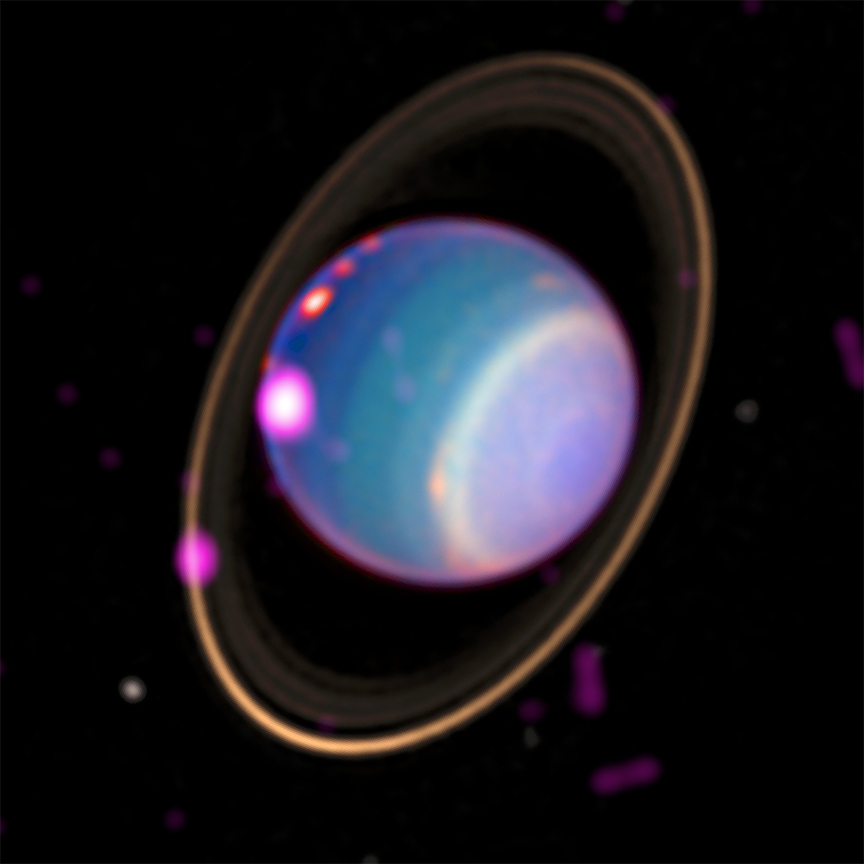Uranus is belching X-rays and is weirder than we ever thought
The more scientists study it, the weirder Uranus gets.
The newest mystery to add to the planet's repertoire? Astronomers have detected X-rays from the strange world — and while some of the signal may be reflected emissions from the sun, some appear to be coming from the planet itself, according to a NASA statement.
That's according to new research that analyzed observations of Uranus gathered by NASA's Chandra X-ray Observatory in 2002 and 2017.
Related: Photos of Uranus, the tilted giant planet

Plenty of solar system objects emit X-rays — everything from Venus to Saturn to moons of Jupiter, the scientists write in a paper describing their research. In fact, of the solar system's planets, only little-studied Uranus and Neptune were missing from the list.
The team of astronomers were particularly drawn to study Uranus in X-rays because the planet's alignments are quite jumbled: the planet lies on its side and the axis of its magnetic field is akimbo from both the orbital plane and the spin axis. The skewed axes may trigger particularly complicated auroras, which can emit X-rays.
So the scientists decided to dig into the scant Chandra observations of Uranus — just three segments of data, one from August 2002 and two from November 2017. The 2002 and 2017 observations also come from different instruments on the telescope, and in the 2017 data, the researchers can't clearly mark which X-rays come from the planet itself and which from elsewhere in the detector's view.
Get the Space.com Newsletter
Breaking space news, the latest updates on rocket launches, skywatching events and more!

All that means that the scientists, as usual, want more observations. But according to the researchers, both patches of data appear to show X-ray emissions from the strange planet — and more than would be expected solely from the planet's atmosphere scattering off X-ray emissions from the sun.
If some of the X-rays the researchers detected are indeed coming from Uranus itself, rather than reflected emissions from the sun, a few phenomena could be at play, the scientists wrote. Saturn's rings produce X-ray fluorescence when hit by charged particles from the sun, and Uranus' two sets of rings may do the same. Or, the X-rays may come from auroras on Uranus, as they do on Jupiter, although scientists aren't positive what would trigger the auroras themselves.
Scientists hope that future observations by Chandra may help determine what's happening at Uranus. Missions yet to launch may also be able to study the planet's X-ray emissions, particularly the European Space Agency's Advanced Telescope for High Energy Astrophysics (ATHENA), due to launch in 2031, or the Lynx X-ray Observatory mission that NASA is considering for launch after its Nancy Grace Roman Telescope.
The research is described in a paper published today (March 31) in the Journal of Geophysical Research.
Email Meghan Bartels at mbartels@space.com or follow her on Twitter @meghanbartels. Follow us on Twitter @Spacedotcom and on Facebook.
Join our Space Forums to keep talking space on the latest missions, night sky and more! And if you have a news tip, correction or comment, let us know at: community@space.com.

Meghan is a senior writer at Space.com and has more than five years' experience as a science journalist based in New York City. She joined Space.com in July 2018, with previous writing published in outlets including Newsweek and Audubon. Meghan earned an MA in science journalism from New York University and a BA in classics from Georgetown University, and in her free time she enjoys reading and visiting museums. Follow her on Twitter at @meghanbartels.









